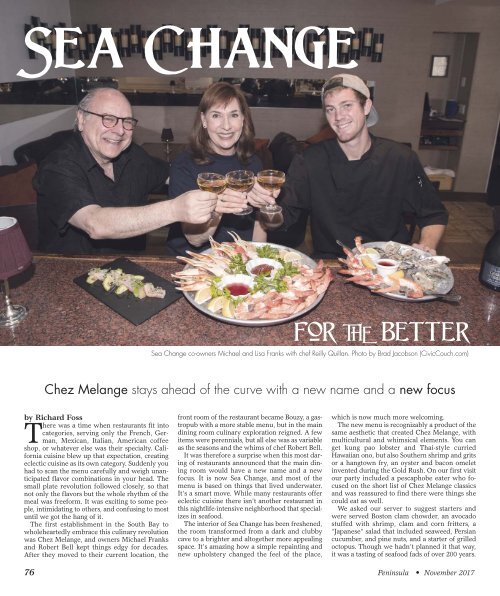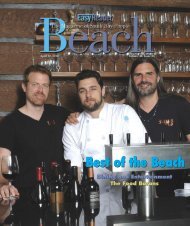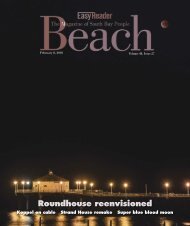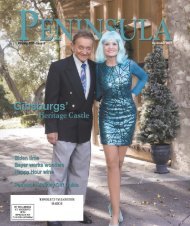Peninsula People Nov 2017
You also want an ePaper? Increase the reach of your titles
YUMPU automatically turns print PDFs into web optimized ePapers that Google loves.
Sea Change<br />
for THE better<br />
Sea Change co-owners Michael and Lisa Franks with chef Reilly Quillan. Photo by Brad Jacobson (CivicCouch.com)<br />
Chez Melange stays ahead of the curve with a new name and a new focus<br />
by Richard Foss<br />
There was a time when restaurants fit into<br />
categories, serving only the French, German,<br />
Mexican, Italian, American coffee<br />
shop, or whatever else was their specialty. California<br />
cuisine blew up that expectation, creating<br />
eclectic cuisine as its own category. Suddenly you<br />
had to scan the menu carefully and weigh unanticipated<br />
flavor combinations in your head. The<br />
small plate revolution followed closely, so that<br />
not only the flavors but the whole rhythm of the<br />
meal was freeform. It was exciting to some people,<br />
intimidating to others, and confusing to most<br />
until we got the hang of it.<br />
The first establishment in the South Bay to<br />
wholeheartedly embrace this culinary revolution<br />
was Chez Melange, and owners Michael Franks<br />
and Robert Bell kept things edgy for decades.<br />
After they moved to their current location, the<br />
front room of the restaurant became Bouzy, a gastropub<br />
with a more stable menu, but in the main<br />
dining room culinary exploration reigned. A few<br />
items were perennials, but all else was as variable<br />
as the seasons and the whims of chef Robert Bell.<br />
It was therefore a surprise when this most daring<br />
of restaurants announced that the main dining<br />
room would have a new name and a new<br />
focus. It is now Sea Change, and most of the<br />
menu is based on things that lived underwater.<br />
It’s a smart move. While many restaurants offer<br />
eclectic cuisine there isn’t another restaurant in<br />
this nightlife-intensive neighborhood that specializes<br />
in seafood.<br />
The interior of Sea Change has been freshened,<br />
the room transformed from a dark and clubby<br />
cave to a brighter and altogether more appealing<br />
space. It’s amazing how a simple repainting and<br />
new upholstery changed the feel of the place,<br />
which is now much more welcoming.<br />
The new menu is recognizably a product of the<br />
same aesthetic that created Chez Melange, with<br />
multicultural and whimsical elements. You can<br />
get kung pao lobster and Thai-style curried<br />
Hawaiian ono, but also Southern shrimp and grits<br />
or a hangtown fry, an oyster and bacon omelet<br />
invented during the Gold Rush. On our first visit<br />
our party included a pescaphobe eater who focused<br />
on the short list of Chez Melange classics<br />
and was reassured to find there were things she<br />
could eat as well.<br />
We asked our server to suggest starters and<br />
were served Boston clam chowder, an avocado<br />
stuffed with shrimp, clam and corn fritters, a<br />
“Japanese” salad that included seaweed, Persian<br />
cucumber, and pine nuts, and a starter of grilled<br />
octopus. Though we hadn’t planned it that way,<br />
it was a tasting of seafood fads of over 200 years.<br />
76 <strong>Peninsula</strong> • <strong>Nov</strong>ember <strong>2017</strong>

















